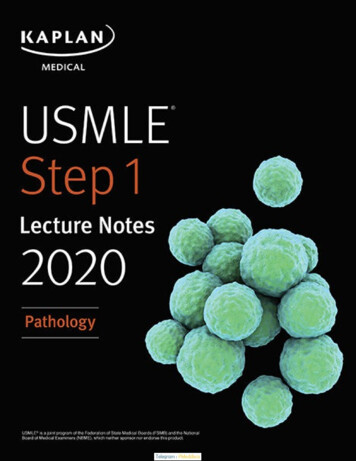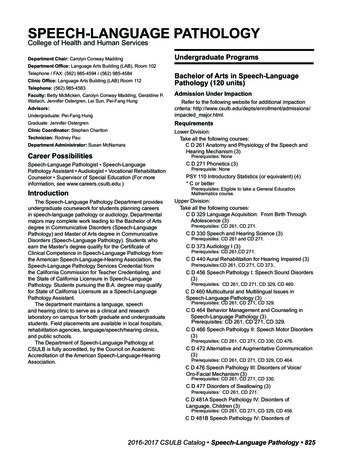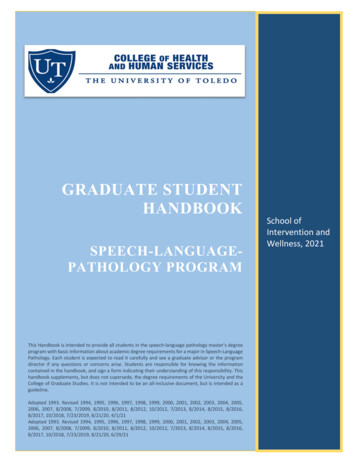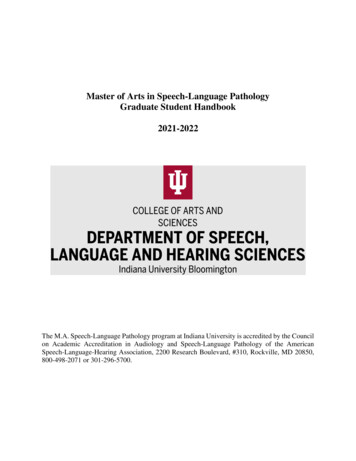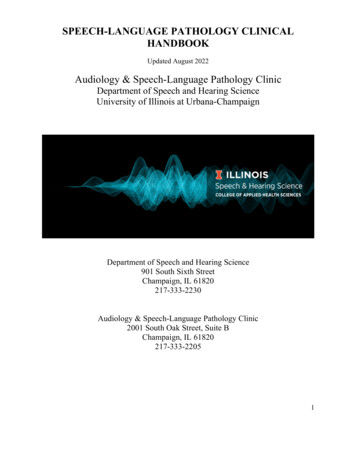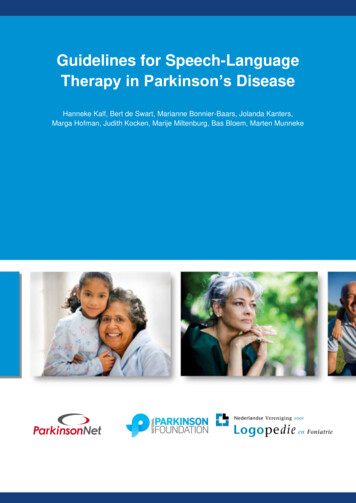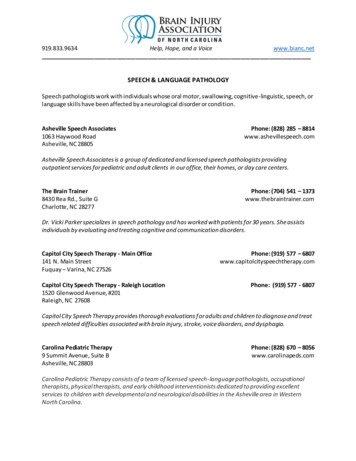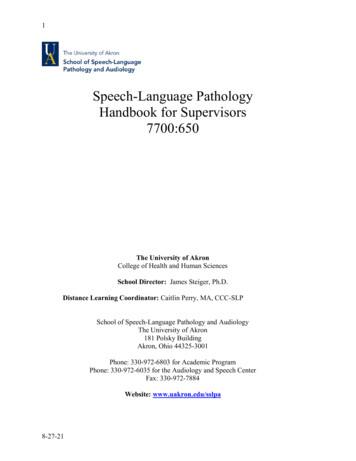
Transcription
1Speech-Language PathologyHandbook for Supervisors7700:650The University of AkronCollege of Health and Human SciencesSchool Director: James Steiger, Ph.D.Distance Learning Coordinator: Caitlin Perry, MA, CCC-SLPSchool of Speech-Language Pathology and AudiologyThe University of Akron181 Polsky BuildingAkron, Ohio 44325-3001Phone: 330-972-6803 for Academic ProgramPhone: 330-972-6035 for the Audiology and Speech CenterFax: 330-972-7884Website: www.uakron.edu/sslpa8-27-21
2Table of Contents:University of Akron Liaison to Extern sitesGoals of the 7700:650 Clinical Practicum Experiences33Graduate Clinician Clinical Assignment- GeneralDistance Learning Clinical Training Program-Sequence44-6Graduate Student Clinician ExpectationsClinical Supervision Guidelines6-77-8Suggested Schedule for Clinical Practicum 7700:650Obtaining and Documenting Clock Hours9-1011-12Grading and EvaluationClinical Support Plan: GuidelinesClinical Support Plan: Form1314-1516-17Appendix:Graduate Program of StudyWeekly Clinical Feedback FormASHA 2020 Certification Standards18-192021-228-27-21
3The University of Akron Liaison to the Extern SitesThe Distance Learning Coordinator serves as the liaison between the School of SpeechLanguage Pathology and Audiology and the external clinical sites for the graduate cliniciansin Speech-Language Pathology. All matters related to the clinical practicums should bebrought to the liaison’s attention.Caitlin N. Perry, M.A./CCC-SLPSpeech-Language Pathology Clinic DirectorThe Audiology and Speech Center(330)972-4667cperry@uakron.eduGoals of the Clinical Practicum Experiences:There are several goals to the clinical practicum experiences:1. To gain competency with communication disorders, service delivery models, andpractice management procedures that may not be available at The University of Akron2. To enable graduate clinicians to experience and better understand the demands andresponsibilities unique to the particular work settings3. To provide graduate clinicians with hands-on training related to clinical report-writing4. To provide graduate clinicians with experiences they need for future employment5. To gain competency working with specific client populations in accordance with ASHAstandards6. To enable graduate clinicians to gain the clinical hours needed to meet the requirementsfor the certification and licensure7. To maintain professional clinical collaboration and interaction between The Universityof Akron and the extern facility8. To prepare the graduate clinicians for their Clinical Fellowship following graduation8-27-21
4Graduate Clinician Clinic AssignmentWhat do I need to know about clinical assignments?The coordinator and students work collaboratively to arrange clinical placements in theircommunities depending upon the graduate clinician’s individual training needs as well asupon his/her level of training and competence. Before a clinical practicum experience canbegin, an affiliation agreement between the University of Akron and the facility must beestablished.In order to receive an assignment, graduate clinicians must be enrolled in the appropriatepracticum course. For the purposes of this handbook, the appropriate practicum course is7700:650.Clinical Practicum experiences are organized so that graduate clinicians meet, at a minimum,licensure requirements of the Ohio Speech and Hearing Professionals Board, certificationrequirements of the American Speech-Language Hearing Association. (ASHA) and licensurerequirements of the Ohio Department of Education. Additional experiences may be requiredto fulfill a graduate clinician’s interests or out of state licensure needs. Students who live outof state are responsible for researching their state licensure requirements and communicatingthis information with the coordinator at the start of the program.Clinical certification requirements are outlined in ASHA’s Certification Handbook forSpeech-Language Pathology or Audiology. This may be found online tion-Handbook.pdf. All membership andcertification forms may be downloaded and printed from the website.What is the Typical Sequence of Clinical Training within the Distance LearningProgram? Three placements (7700:650) are introductory in nature. Each of the three initial placements should be attended a minimum of 2 days perweek across the entire span of the semester. Exceptions to this schedule may bemade according to the unique circumstances of a particular setting. Exceptionsor modifications need to be approved by the University coordinator. One placement must be completed with pediatrics and another placement mustbe completed with adults. The third placement is optional (pediatrics vs. adults). Students should obtain a minimum of 50 direct clinical hours during each ofthese rotations. These “introductory” placements are meant to: Provide graduate students with their first experiences evaluating and treatinga variety of disorders and populations.8-27-21
5 For reference, two placements follow the introductory placements and are consideredthe “advanced” externship rotations:The student has already obtained 100-150 direct clinical hours leading up to the startof the externships. Occur after the abovementioned “introductory” placements.One externship is completed in a school setting (i.e. school externship)One externship is completed in an adult medical setting (i.e. medical externship).Each of these two externship placements should be attended a minimum of 3 daysper week across the entire span of the semester. Students may also complete theexternship(s) 5 full days per week across 8 weeks.Students should obtain a minimum of 125 direct clinical hours during each of theseexternships.Refer to the appropriate handbook provided by the graduate coordinator forexpectations and suggested schedule of activities across the term.o School externship handbooko Medical externship handbook Expose graduate students to a variety of settings and service deliverymodels.Provide hands-on training for clinical report writing.Gradually ease the student clinician into taking over the caseload. Studentsbegin by observing, then participating in activities with the SLP, andgradually begin leading/owning sessions as the semester progresses.This handbook is written to offer guidance to supervisors who arehosting graduate student clinicians during one of these threeintroductory placements.Supplemental (Mandatory) Clinical Training Assignments: 1) SimulatedDiagnostic Clinic 2) Simucase1) Beginning with our 2021 “start” cohort, students participate in a simulateddiagnostic clinic offered by University of Akron clinical supervisors. Students gainexperience with the following, as it relates to the pediatric and adult population: 8-27-21Develop an assessment plan based on client data and evidence-based practice.Administer different types of standardized and authentic assessments.Evaluate and compare the psychometric properties of norm-referencedassessments to guide in the selection of assessments.Create or modify informal assessments based on client needs.Score assessments based on standardization rules.Interpret data and develop an assessment report.Make appropriate referrals based on assessment data.
62) Students complete simulated cases via Simucase and participate in group debriefingmeetings with University of Akron clinical supervisors, in order to provide them withexperience and training in “hard to fill” disorder areas (i.e. fluency, voice, AAC).The use of clinical training via simulated cases will contribute to the following graduatestudent outcomes: To meet competency skills training requirements across the scope of practice inspeech-language pathology, which is required for professional licensureTo enhance knowledge of the disorder areas given the opportunity to applyinformation learned in lecture directly to clinical casesTo be better prepared for live externship rotations through ability to transfer andapply knowledge and skills obtained through successful completion of simulatedcasesExpectations of Graduate CliniciansWhat is expected of graduate clinician clinicians?Attendance:Student attendance during clinical practicum is mandatoryGraduate clinicians are not permitted to be absent from clinical practicum unless the absenceis excused by the Distance Learning Coordinator and the Clinical Supervisor. Reasons forexcused absences include: Personal illness/injury Significant illness/injury of immediate family (spouse, parents, children,grandparents, siblings, grandchildren) to care for the family member Exposure to contagious disease which can be communicated to other Funeral, memorial service, or wake Religious holidays/observation Medically necessary appointment that cannot be scheduled at an alternative time Other reasons approved by Distance Learning Coordinator and Clinical Supervisor.Graduate clinicians may be required to provide documentation of absences. Unexcusedabsences or a frequent pattern of excused absences without appropriate documentation mayresult in a deduction in letter grade and/or an In-Progress (IP) for the practicum experience.Student with an excused absence must contact his/her SLP supervisor and Coordinator assoon as possible.If the SLP supervisor has concerns regarding student attendance, s/he will coordinate ameeting with the student, SLP supervisor, and the Coordinator to discuss concerns anddetermine a course of action.8-27-21
7If the University of Akron is closed, but the facility remains open, the graduate clinician isexpected to report to their clinical placement site.Schedule for Introductory Placements (700:650):Graduate clinicians are expected to attend clinical placements a minimum of 2 days per weekduring the entire length of the semester, including finals week. The SLP supervisor andGraduate clinician can determine a weekly schedule (i.e. Monday/Wednesday,Tuesday/Thursday); the Coordinator does not need to be involved in this discussion.Graduate clinicians are expected to attend the entire day that the SLP supervisor is scheduled.Dress, Grooming, and Appearance:Graduate clinicians are expected to dress for evaluations and therapy in an appropriate,professional manner, i.e. in attire appropriate to any place of business. Clothing which iseither too casual or too dressy, i.e. shorts, sundresses, very short skirts, jeans, tee-shirts,sweatshirts, party wear, see-through clothing, etc., is out of place in a clinical workenvironment. In general, a clean, neat pair of pants, a dress, a skirt, together with a blouse,shirt, jacket or sweater is considered to be appropriate. Bare midriffs, plunging necklines andlow-rise pants are not allowed. Makeup, jewelry, and hair color should be tasteful. Obviousbody piercings or tattoos should be removed or covered during clinic.Clinical Supervisors should inform graduate clinicians about specific dress codes prior to thestart of the rotation.Timeliness:Graduate clinicians are expected and required to be on time for all clinical appointments.Furthermore, they are expected to arrive ahead of appointment times to prepare for sessionsand to begin on time. Graduate clinicians should contact the clinical supervisor immediatelyif there are circumstances beyond their control that cause them to be late.Identification:Graduate clinicians can wear a University Zip Card name badge, if required at the facility.Please note that our Distance Learning students do not acquire University badges unlessspecifically requested and purchased for the purpose of a clinical practicum experience. Thestudent will need to contact the Zip Card Office at the University of Akron in advance of thestart of the placement to order a badge.Clinical Supervision GuidelinesWhat are the clinical supervision requirements for graduate clinicians?ASHA Standard V-E: Supervision of graduate clinicians must be provided by a clinicaleducator who holds ASHA certification in the appropriate profession, who has the equivalentof a minimum of 9 months of full-time clinical experience post-certification, and who has8-27-21
8completed a minimum of 2 hours of professional development in clinicalinstruction/supervision after being awarded ASHA certification.The amount of direct supervision must be commensurate with the graduate clinician’sknowledge, skills, and experience; must not be less than 25% of the graduate clinician's totalcontact with each client/patient; and must take place periodically throughout the practicum.Supervision must be sufficient to ensure the welfare of the individual receiving services.It is understood that in a clinical training program, clinical supervision takes place accordingto the training level and individual needs of each graduate clinician and each client served.ASHA standards specify a minimum of 25% supervision; however, clinical supervisiontime must be adjusted accordingly for beginning clinicians and adjusted as thegraduate clinician become more independent.To assure a quality clinical learning experience for graduate clinicians, we suggest thatsupervisors: Create a positive learning environment that fosters the graduate clinician’s professionaland personal growth Establish and maintain an effective working relationship with the supervisee Orient the graduate clinician to the facility Provide the graduate clinician with instructional materials, access to the records,facilities, and facility policies Assist the supervisee in developing clinical goals and objectives Demonstrate clinical methods and participate with the supervisee in the clinical process Assist the supervisee in developing and refining assessment skills Assist the supervisee in developing and refining practice management skills Assist the supervisee in developing and refining therapeutic skills Assist the supervisee in analyzing assessment and treatment sessions Assist the supervisee in the development and maintenance of clinical records (e.g.medical records, ETR, IEP or IFSP) Assist the supervisee in preparing, executing, and analyzing interprofessional/teaminteractions Assist the supervisee in self-evaluation of clinical performance Assist the supervisee in developing skills of verbal counseling and communication withteam members Share information regarding ethical, legal, regulatory, and reimbursement aspects ofprofessional practice Model and facilitate professional conduct Demonstrate research skills in the clinical or supervisory processes Complete on-going clinical performance evaluations to include, but not limited to,midterm and finalGraduate clinicians cannot be left alone at a facility without a SLP supervisor due to theconcern of liability for personal harm/injury, damage/theft of property, and access toconfidential client/patient records. If the SLP supervisor is unavailable, then graduateclinicians may be present during facility business hours when facility employees (i.e. other8-27-21
9school staff or hospital staff) are present. SLP supervisor must be present while graduateclinician(s) are in the facility outside of facility business hours. A graduate clinician is notpermitted to complete direct client care if a licensed SLP is not on the premises.8-27-21
10Suggested Schedule for Clinical Practicum Experiences (Introductory/7700:650)The activities listed below are suggestions to the type of schedule that could be followed toprovide graduate clinicians with a diverse and beneficial clinical practicum experience. Anindividualized plan should be developed based on the facility’s requirements and /orcapabilities, the supervisor’s schedule, pre-established procedures, and the graduateclinician’s capabilities.Time FrameSuggested ActivityPrior to initiation of Completion and submission of facility-specific onboardingclinical practicumrequirements, which may include documentation of physicalexam, immunizations, and background check(s) Graduate clinician and SLP supervisor review practicumguidelines Graduate clinician and SLP meeting via phone, web-based,or in-person conference (optional meeting) Discuss expectations and learning style Confirm weekly schedule Consider reading materials or supplemental materials thatmay support the graduate clinician’s trainingWeeks One & Two Weeks Three & Four 8-27-21Orientation to building and siteBecome familiar with site procedures including code ofconduct, fire/tornado, etc.Obtain information about risk management and infectioncontrol procedures followed by siteIntroductions to staff and other professionalsAttend meetings or other professional SLPactivities/responsibilitiesSchedule a weekly meeting, if possibleBecome familiar with facility diagnostics and therapeuticprotocolsBecome familiar with the client-record system and beginreviewing clients’ records/filesDiscuss lesson plan procedures, data collection system, andclinical- report writingObserve and jointly participate in intervention sessions withsupervising SLP, as appropriateObserve clients during other activities (i.e. other therapyappointments, in the classroom)Plan and lead intervention for up to 25% of shared caseloadFor remaining caseload, continue to observe but jointlyparticipate in sessions on a more frequent basisContribute to clinical documentationSLP supervisor completes and reviews Weekly ClinicalFeedback Form (Optional; see Appendix)
11Weeks Five & Six Weeks Seven &Eight Weeks EightThrough the End ofClinical Practicum 8-27-21Plan and implement intervention and/or evaluation for 25%to 50% of shared caseload. Complete appropriatedocumentation for assigned caseloadFor remaining caseload, continue to observe but jointlyparticipate in sessions on a more frequent basis. Contribute toclinical documentationActively participate in staff & patient care meetingsSLP supervisor completes and reviews Weekly ClinicalFeedback Form (Optional; see Appendix)Plan and implement intervention and/or evaluation for 5075% of shared caseload. Complete appropriatedocumentation for assigned caseloadFor remaining caseload, continue to observe but jointlyparticipate in sessions on a more frequent basis than in weeksprior. Contribute to clinical documentationActively participate in staff & patient care meetingsFormal review of midterm evaluationSLP supervisor completes and reviews Weekly ClinicalFeedback Form (Optional; see Appendix)Plan and implement intervention and/or evaluation for 50%to 100% of the shared caseload. Complete appropriatedocumentation for assigned caseloadFor remaining caseload, continue to observe but jointlyparticipate in sessions on a more frequent basis than in weeksprior. Contribute to clinical documentationActively participate in staff & patient care meetingsConsult with other professionals as it relates to patient careComplete family interviews and family counselingOther responsibilities required by the supervisor and/orfacilitySLP supervisor completes and reviews Weekly ClinicalFeedback Form (Optional; see Appendix)Formal review of final evaluation & approval of all clockhours
12Obtaining and Documenting Clinical Clock HoursWhat are ASHA’s standards for obtaining and documenting clinical clock hours forcertification in Speech-Language Pathology and Audiology?The graduate clinician is required to log the amount of time spent participating in directclient contact. These clock hours are tracked in the on-line management system, Calipso in. This system helps to keep accuraterecords of graduate clinicians’ clinical hours that are maintained for graduation, for ASHAcertification and state licensure purposes. Graduate clinicians receive instructions on usingthe Calipso management system when they enter our graduate program.Prior to supervising a graduate clinician, each supervisor will be emailed instructions and aone-time PIN to register for his/her free supervisor account. Once a supervising SLP hasregistered, he/she will remain in the Calipso management system for subsequent semesters.Supervisors approve all clinical clock hours within the Calipso management system.In order to count clinical clock hours toward meeting certification and/or licensurerequirements, a graduate clinician must be actively involved in the diagnostic or interventionprocess.Active involvement includes the following activities when the client is present andparticipating: Actual service delivery (therapy or diagnostics) Recording and analyzing data during the session Interviewing and counseling with clients/families regarding treatmentrecommendations, home programming, etc. Managing client’s behavior Managing technological devices with the client present (speech-generating devices,assistive listening devices, preparing computer programs for sessions) Clinical documentation with the client presentThe following activities CANNOT be counted towards clinical clock hours: Report writing without the client present and participating Planning sessions Learning to administer tests or procedures Passively observing without active involvement with the client/family Interprofessional or staff meetings without the client present and participating Conference time with supervisorIf you are in doubt about the legitimacy of an activity, consult the Coordinator.Supervision of Clock Hours:Persons holding the CCC-SLP may supervise: All Speech-Language Pathology evaluations and treatment services8-27-21
13 Aural habilitation and rehabilitation servicesAudiologic screening (i.e. pure-tone air conduction screening and testing, andscreening tympanometry) for the purpose of the initial identification and/or referral ofindividuals other communication disorders or possible middle ear pathologyManagement of children and adults with central auditory processing disordersPersons holding the CCC-A may supervise: Audiologic evaluation/assessment Intervention for central auditory processing disorders Amplification (hearing aid selection and management) Speech and/or language screening for the purpose of initial identification ofindividuals who may have other communication disorders Aural habilitation and rehabilitation services Evaluation and management of children and adults with central auditory processingdisordersHow do graduate clinicians keep track of clinical clock hours?Graduate clinicians are required to log the amount of time spent participating in direct clientcontact. These clock hours are tracked by a web-based program, Calipso. Graduate cliniciansare required to enter their clock hours information into this system and monitor it to assurethat their clock hours are correct and that they are approved by their supervisor(s). All clockhours must be entered by the graduate clinician into Calipso prior to the end of the clinicalplacement. Errors in entering clock hours or failure to submit clock hours may result in an InProgress (IP) for the practicum experience, and/or delay or prevention of ASHA certificationor state licensure. The accuracy of your clinical hours is NOT the Clinical Instructor’sresponsibility-it is the graduate clinicians’! It is strongly recommended that graduateclinicians maintain a personal record of clinical hours.8-27-21
14How are graduate clinicians graded for clinic?Evaluation and Grades:At a minimum, graduate clinicians should be provided with a formal verbal and writtenevaluation twice during the experience; once at the midterm and again at final. ClinicalPerformance Evaluations are completed using an on-line management system, Calipso.During the evaluation, the graduate clinician and supervisor should discuss the graduateclinician’s strengths and areas in need of improvement. Efforts should be made to establishobjectives for improving performance.Helpful Tips When Completing the Calipso Midterm and Evaluation: Supervisors should mark off all of the pertinent fields in the top section (i.e. patientpopulation, severity of disorders, interprofessional practice). This is important for thegraduate clinicians’ clinical documentation for ASHA licensure. Supervisors will only need to provide a score in any of the clinical areas that thegraduate student clinician had the opportunity to practice. All other areas can be leftblank. Course number:o 7700:650o # the number of clinical practicum rotations that the graduate clinician hascompleted (i.e. if this is the first practicum 1st, if this is the secondpracticum 2nd)o Advanced; Distance Learning students will rarely use the Standard categoryo Year 1Example: 7700:650 1stAd 1-1st Advanced Practicum Year8-27-21
15What if a graduate clinician needs support in his/her academic achievement or clinicalskills?Academic and Clinical Support Plans:If a graduate clinician scores “3” or lower on any category of the Clinical PerformanceEvaluation or if s/he fails to demonstrate competency with the skills and abilities as outlined inthe Technical Standards, a Clinical Skills Support Plan form must be completed. Support plan isdesigned to support students in achieving competence in knowledge, skills, and abilities that areoutlined in course syllabi, Clinical Performance Evaluation, and the Technical Standards. If agraduate clinician requires a Support Plan, the appropriate coordinator (Clinic Director orExternship Coordinator for clinical support plans, or Graduate Coordinator for academic supportplans) will assist with development of the Support Plan.Procedures:Support plans can be either academically or clinically based. The instructor(s) and/orsupervisor(s), along with the appropriate coordinator(s) are responsible for creating a plan basedon knowledge, skill, or ability deficiencies demonstrated by a graduate clinician with theacademic or clinical setting. Once a plan has been devised, the instructor/supervisor must reviewand discuss the plan with the graduate clinician. After doing so, the graduate clinician,instructor/supervisor, and coordinator must sign and date the plan, acknowledging the goalscreated, and the anticipated completion date/deadline. A copy of the signed support plan must beprovided to the graduate clinician, the graduate clinician’s graduate file, thesupervisor/instructor, and the Clinic Director (clinic) or Graduate Coordinator (academic).Prior to the start of a new clinical semester, the graduate clinician’s supervisor(s) will be notifiedand receive a copy of the graduate clinician’s plan from the Clinic Director.The instructor(s) and/or supervisor(s) will assist the graduate clinician with development ofknowledge, skill, and/or ability area(s) specified on the Support Plan. This assistance mayinclude strategies including but not limited to: written feedback, verbal feedback, modeling of askill, clinician self-assessments, research into a disorder, audio taping, videotaping, skillproficiency checklists, review of policies/procedures, in-services, supplemental readings, regularsupervisory conferences, data collection by supervisor or the graduate clinician.Until the plan is completed, the graduate clinician must meet with their instructor(s) and/orsupervisor(s) on a pre-determined schedule to discuss progress made toward accomplishing thespecified plan goals. The plan goals must be achieved no later than the end of the subsequentsemester.If an instructor(s) and/or supervisor(s) observes minimal to no improvement and/or failure of thegraduate clinician to meet the plan deadline, the instructor(s) and/or supervisor(s) must informthe Graduate Coordinator. In this situation, the Coordinator will set up a meeting with thegraduate clinician to discuss potential plans of action, e.g., delay externship placement, repeatinga course, extension of a graduate clinician’s program, etc.8-27-21
16Completion of the clinical support plan goals will be verified by the Coordinator; thisverification will be provided by the graduate clinician’s current or subsequent supervisor oncethe plan is in place. Once the plan has been completed, the Coordinator will document thegraduate clinician’s attainment of goals on the original plan or as a written addendum.Completion of the academic support plan goals will be verified by the Graduate Coordinator; thisverification will be provided by the graduate clinician’s current or subsequent instructor once theplan is in place. Once the plan has been completed, the School Director will document thegraduate clinician’s attainment of goals on the original plan, or as a written addendum.Clock Hours:If a graduate clinician receives an average of 3.9 or lower as their final clinical grade on anyCalipso evaluation, the graduate clinician will not be granted the hours for that clinicalexperience.8-27-21
17Clinical Support Plan FormGraduate Clinician Name:Clinic Supervisor/Course Instructor:Clinic/Course:Semester: Year:This support plan was developed in order to allow the graduate clinician to address deficienciesin coursework and/or clinical training. This plan is intended to remediate those deficiencies andallow the graduate clinician to acquire the necessary knowledge and skills and achieve thetechnical standards. The graduate clinician and supervisor/instructor will develop a support planin order to achieve competency in any identified deficiency deficient area.Directions: Enter the ASHA standard and course/clinic objective that has not been met. Identifythe additional responsibilities of the graduate clinician and the role(s) of the supportingsupervisor/instructor.Support PlanStandard/ObjectiveGraduate clinician ResponsibilitiesInstructor RolesBegin date:MetNot Met8-27-21Review date:Date:Supervisor/Instructor:Clinic Director/Graduate Coordinator:
18Support PlanStandard/ObjectiveGraduate clinician ResponsibilitiesInstructor RolesBegin date:MetNot MetReview date:Date:Supervisor/Instructor:Clinic Director/Graduate Coordinator:In the event that a graduate clinician is unable to fulfill t
Speech-Language Pathology . Handbook for Supervisors . . Distance Learning Coordinator: Caitlin Perry, MA, CCC-SLP . School of Speech-Language Pathology and Audiology . The University of Akron . 181 Polsky Building . Akron, Ohio 44325-3001 . Phone: 330-972-6803 for Academic Program . Phone: 330-972-6035 for the Audiology and Speech Center .
